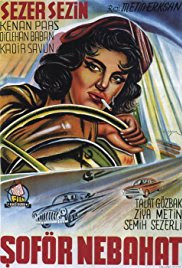Mavi Boncuk |
![]() Şoför: chauffeur[1] driver[2]
Şoför: chauffeur[1] driver[2]
[ Mehmed Bahaeddin (Toven), Yeni Türkçe Lugat, 1924] şoför: Otomobil sevk ve idare eden. Buhar kazanının ateşini yakan. ~ Fr chauffeur 1. buharlı gemi veya lokomotifte ateşçi [esk.], 2. motorlu araç sürücüsü < Fr chauffer ısıtmak +()tor → şofben
[1] chauffeur (n.)
![]() 1896, "a motorist," from French chauffeur, literally "stoker," operator of a steam engine, French nickname for early motorists, from chauffer "to heat," from Old French chaufer "to heat, warm up; to become hot" (see chafe). The first motor-cars were steam-driven.
1896, "a motorist," from French chauffeur, literally "stoker," operator of a steam engine, French nickname for early motorists, from chauffer "to heat," from Old French chaufer "to heat, warm up; to become hot" (see chafe). The first motor-cars were steam-driven.
Sense of "professional or paid driver of a private motor car" is from 1902.
The '95 Duryea wagon, which won the Chicago contest last Fall, was exhibited at the Detroit Horse Show last week. Charles B. King, treasurer of the American Motor League, acted as "chauffeur," as the French say. ["The Horseless Age," April 1896]
chauffeur (v.) "convey by car, drive as a chauffeur," 1902, from chauffeur (n.). Related: Chauffeured; chauffeuring.
Borrowed from French chauffeur.
chauffeur
Czech: šofér
Dutch: chauffeur
English: chauffeur
Persian: شوفر (šufer)
Polish: szofer
Portuguese: chofer
Russian: шофёр (šofjór)
Serbo-Croatian: шо̀фе̄р m/šòfēr
Spanish: chofer
Swedish: chaufför
chafe (v.)
c. 1300, chaufen, "be provoked, grow or be excited;" late 14c. in literal sense "to make warm, to heat" (also intransitive, "to grow warm or hot"), especially (early 15c.) "to warm by rubbing, excite heat by friction," from Old French chaufer "heat, warm up, become warm" (12c., Modern French chauffer), from Vulgar Latin *calefare, from Latin calefacere "to make hot, make warm," from calere "be warm" (from PIE root *kele- (1) "warm") + facere "to make, do" (from PIE root *dhe- "to set, put").
From 1520s as "abrade the skin by rubbing." Figurative senses from late 14c. include now-obsolete "kindle (joy), inspire, make passionate" as well as "provoke, vex, anger." Related: Chafed; chafing. Chafing-dish is from late 15c.
[2]
driver (person who drives a motorized vehicle, such as a car or a bus)driver (n.) "one who drives" in various senses, c. 1400; agent noun from drive (v.). Slavery sense is attested by 1796. Driver's seat is attested by 1867; figurative use by 1954.
 Şoför: chauffeur[1] driver[2]
Şoför: chauffeur[1] driver[2][ Mehmed Bahaeddin (Toven), Yeni Türkçe Lugat, 1924] şoför: Otomobil sevk ve idare eden. Buhar kazanının ateşini yakan. ~ Fr chauffeur 1. buharlı gemi veya lokomotifte ateşçi [esk.], 2. motorlu araç sürücüsü < Fr chauffer ısıtmak +()tor → şofben
[1] chauffeur (n.)
 1896, "a motorist," from French chauffeur, literally "stoker," operator of a steam engine, French nickname for early motorists, from chauffer "to heat," from Old French chaufer "to heat, warm up; to become hot" (see chafe). The first motor-cars were steam-driven.
1896, "a motorist," from French chauffeur, literally "stoker," operator of a steam engine, French nickname for early motorists, from chauffer "to heat," from Old French chaufer "to heat, warm up; to become hot" (see chafe). The first motor-cars were steam-driven. Sense of "professional or paid driver of a private motor car" is from 1902.
The '95 Duryea wagon, which won the Chicago contest last Fall, was exhibited at the Detroit Horse Show last week. Charles B. King, treasurer of the American Motor League, acted as "chauffeur," as the French say. ["The Horseless Age," April 1896]
chauffeur (v.) "convey by car, drive as a chauffeur," 1902, from chauffeur (n.). Related: Chauffeured; chauffeuring.
Borrowed from French chauffeur.
chauffeur
Czech: šofér
Dutch: chauffeur
English: chauffeur
Persian: شوفر (šufer)
Polish: szofer
Portuguese: chofer
Russian: шофёр (šofjór)
Serbo-Croatian: шо̀фе̄р m/šòfēr
Spanish: chofer
Swedish: chaufför
chafe (v.)
c. 1300, chaufen, "be provoked, grow or be excited;" late 14c. in literal sense "to make warm, to heat" (also intransitive, "to grow warm or hot"), especially (early 15c.) "to warm by rubbing, excite heat by friction," from Old French chaufer "heat, warm up, become warm" (12c., Modern French chauffer), from Vulgar Latin *calefare, from Latin calefacere "to make hot, make warm," from calere "be warm" (from PIE root *kele- (1) "warm") + facere "to make, do" (from PIE root *dhe- "to set, put").
From 1520s as "abrade the skin by rubbing." Figurative senses from late 14c. include now-obsolete "kindle (joy), inspire, make passionate" as well as "provoke, vex, anger." Related: Chafed; chafing. Chafing-dish is from late 15c.
[2]
driver (person who drives a motorized vehicle, such as a car or a bus)driver (n.) "one who drives" in various senses, c. 1400; agent noun from drive (v.). Slavery sense is attested by 1796. Driver's seat is attested by 1867; figurative use by 1954.
